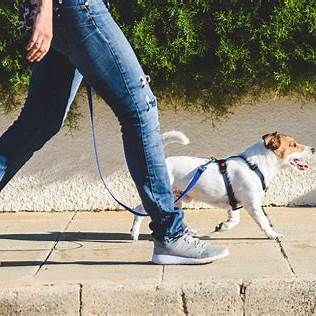Walking Should Be Fun — So Why Is It So Frustrating?
You grab the leash, your dog hears the jingle, and they’re instantly buzzing with excitement. But the moment you step outside, that excitement can turn into pulling, barking, lunging, freezing, or complete chaos.
If your otherwise well-behaved dog turns into a completely different animal on walks, you’re not alone — and it’s not your fault. Many dog owners struggle with leash behavior, even if their pup listens perfectly at home.
In this post, we’ll explore why walks bring out the worst behavior in some dogs, what it means, and how you can turn your walks from stressful to smooth with smart training adjustments.

What Causes Leash-Related Behavior Changes?
1. Leash Pressure and Tension
Leashes, by design, restrict movement. For dogs, this can be frustrating — especially when they want to sniff, run, or react freely. The more tension they feel, the more pressure builds, which can trigger pulling, barking, or freezing. This is known as leash reactivity, and it’s extremely common.
2. Environmental Overload
Outdoors, your dog is exposed to more stimuli than they encounter indoors — fast cars, squirrels, dogs, joggers, loud sounds, smells, and movement. Some dogs become overstimulated, while others go into defense mode. Without proper training, the result is chaos.
3. Excitement or Anxiety
Some dogs pull because they’re excited, while others shut down from fear. Walks can trigger both extremes. The leash becomes a barrier, and your dog doesn’t know how to regulate their emotions.
Common Problem Behaviors on Walks
-
Pulling: Constant tension on the leash, especially toward people, dogs, or distractions.
-
Lunging/Barking: Sudden outbursts when passing other dogs or people.
-
Freezing or Refusing to Walk: Fear-based hesitation in unfamiliar areas.
-
Zigzagging or Lagging: Inconsistent pacing that causes frustration and miscommunication.
-
Sniffing Obsessively: Hyper-focus on scents with no engagement or responsiveness.
These behaviors aren’t signs of a “bad dog” — they’re simply signs that your dog hasn’t learned how to navigate outdoor environments calmly and confidently.
How to Fix Leash Behavior Issues
1. Start Indoors or in Low-Distraction Areas
Many owners expect their dog to perform outside what they haven’t mastered inside. Start by building engagement and responsiveness indoors or in a quiet yard. Once your dog can walk calmly and respond to commands there, gradually add distractions.
2. Use a Structured Walking Routine
Structure brings predictability. Begin each walk with a clear set of expectations:
-
Exit calmly
-
Use the same side or position every time
-
Incorporate brief stops for obedience (sits, focus, heel)
-
End with a calm release or free sniffing time
Consistency teaches your dog that walks have rules and rewards.
3. Teach Leash Pressure Communication
Leash pressure should be information, not punishment. Use light, consistent leash guidance to communicate direction and boundaries. Reinforce correct behavior with praise, treats, or freedom.
Avoid retractable leashes or yanking — they confuse the dog and often reinforce the wrong behaviors.
4. Reward Neutrality, Not Just Obedience
If your dog sees another dog and doesn’t react — reward it. Not reacting is a behavior too. Rewarding calmness, neutrality, and self-control builds emotional resilience.
5. Practice Engagement on the Move
Use name recognition, “look at me,” hand targets, or food games to build engagement during movement. These exercises keep your dog mentally focused on you rather than the environment.
Leash Training Tools to Consider
Training tools are not shortcuts — they’re communication aids. Depending on your dog’s breed, age, size, and energy level, tools like slip leads, martingale collars, or balanced training equipment (when used correctly) can help speed up progress.
Never rely solely on tools to manage behavior — combine them with structure, praise, and accountability.
Why Walks Are the Ultimate Test of Obedience
Walking calmly through a public space is one of the highest forms of obedience. It requires:
-
Focus
-
Impulse control
-
Trust in the handler
-
Ability to manage distractions
That’s why leash behavior is one of the most sought-after training goals for dog owners — and one of the most rewarding to achieve.
Progress Takes Patience and Repetition
There’s no one-size-fits-all fix. Some dogs improve in a few days, others need weeks of consistent work. The key is:
-
Consistency in routine and communication
-
Patience when setbacks happen
-
Practice in a variety of environments
Celebrate small wins, and know that progress on the leash leads to improvement in all other areas of your dog’s behavior.
Summary: Better Walks Begin with Better Communication
Your dog isn’t being stubborn — they’re confused, overwhelmed, or untrained in the context of a real-world walk. Once you show them what’s expected and reward the behavior you want, leash walks become enjoyable, not exhausting.
Training isn’t about removing your dog’s personality — it’s about shaping their response to the world around them. Every walk is a chance to build trust, leadership, and freedom — all through better communication on the leash.
Looking for professional dog training in Cleveland?
At Off Leash K9 Training in Cleveland, we specialize in transforming dogs into well-mannered, obedient companions—on and off the leash. Our programs are tailored to your dog’s unique personality and training needs. Whether you’re struggling with reactivity, recall, leash pulling, or just want better behavior around the house, we’ve got you covered. We believe every dog can be trained, and we’ll guide you step-by-step through the process with proven methods that deliver real, lasting results. Call us today at (440) 448-6004 to begin your dog’s transformation.

